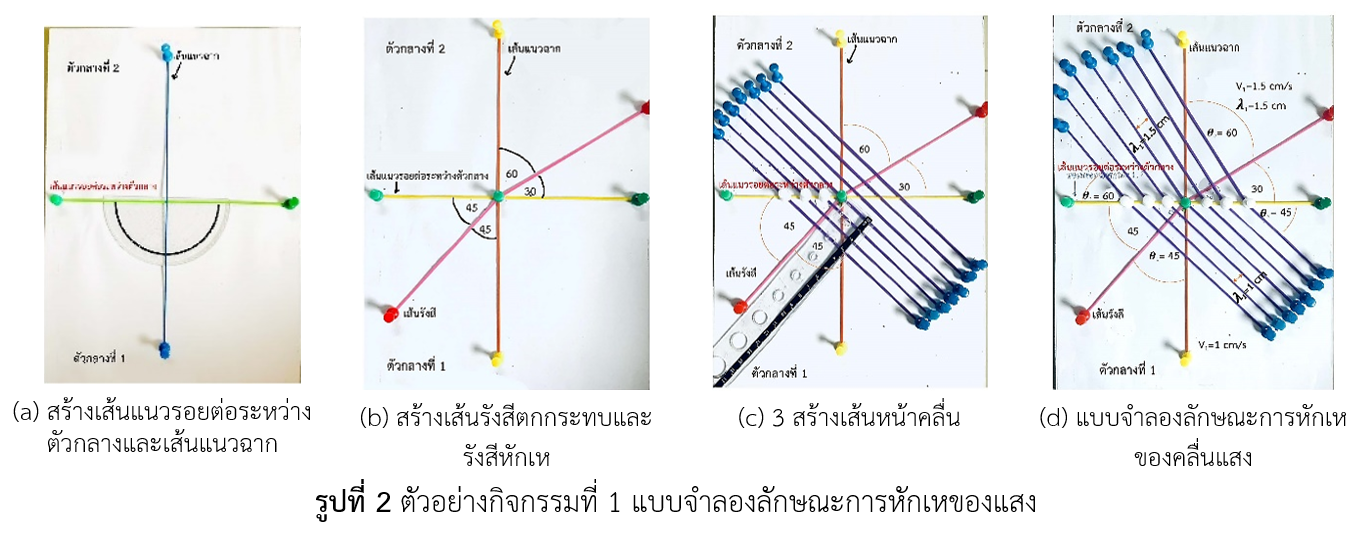โมเดลอย่างง่ายจากหนังยางเพื่อสืบเสาะกฎของสเนลล์
Main Article Content
บทคัดย่อ
การทดลองเป็นวิธีการทางวิทยาศาสตร์ในการค้นหาความรู้ ทดสอบสมมติฐาน หรือศึกษาปรากฏการณ์ การทดลองการหักเหของคลื่นแสงจำเป็นต้องใช้วัสดุอุปกรณ์ที่แสดงให้เห็นปรากฏการณ์ได้อย่างชัดเจน เพื่อไม่ให้ผู้เรียนเกิดแนวคิดคลาดเคลื่อน ผู้วิจัยจึงพัฒนาแบบจำลองการหักเหของคลื่นแสงอย่างง่ายจากหนังยาง งานวิจัยนี้มีวัตถุประสงค์เพื่อพัฒนาความเข้าใจแนวคิดเรื่องการหักเหของคลื่นแสงของนักเรียน ก่อนและหลังการจัดการเรียนรู้แบบสืบเสาะหาความรู้ร่วมกับแบบจำลองการหักเหของคลื่นแสงอย่างง่าย กลุ่มตัวอย่างเป็นนักเรียนชั้นมัธยมศึกษาปีที่ 5 ภาคเรียนที่ 2 ปีการศึกษา 2563 จำนวนนักเรียน 36 คนได้มาโดยวิธีการเลือกแบบเจาะจง เครื่องมือที่ใช้ในการเก็บรวบรวมข้อมูล ประกอบด้วยแผนการจัดการเรียนรู้แบบสืบเสาะหาความรู้ จำนวน 2 แผน และ แบบทดสอบความเข้าใจเรื่องการหักเหของแสง วิเคราะห์ข้อมูลโดยการทดสอบที (t-test) และค่าความก้าวหน้าทางการเรียนตามวิธีของ Hake ผลการวิจัยพบว่าผู้เรียนมีคะแนนจากแบบทดสอบเรื่องการหักเหของคลื่นแสงหลังเรียนสูงกว่าก่อนเรียนอย่างมีนัยสำคัญทางสถิติที่ระดับ .05 ค่าความก้าวหน้าทางการเรียน เท่ากับ 0.71 จัดอยู่ในระดับสูง และยังพบอีกว่าหลังเรียนนักเรียนให้เหตุผลถูกต้องเพิ่มขึ้น แสดงให้เห็นว่าการจัดการเรียนรู้แบบสืบเสาะร่วมกับแบบจำลองการหักเหของแสงอย่างง่ายสามารถพัฒนาความเข้าใจแนวคิดเรื่องการหักเหของคลื่นแสงได้อย่างมีประสิทธิภาพ
Article Details

อนุญาตภายใต้เงื่อนไข Creative Commons Attribution-NonCommercial-NoDerivatives 4.0 International License.
วารสารวิทยาศาสตร์และวิทยาศาสตร์ศึกษา (JSSE) เป็นผู้ถือลิสิทธิ์บทความทุกบทความที่เผยแพร่ใน JSSE นี้ ทั้งนี้ ผู้เขียนจะต้องส่งแบบโอนลิขสิทธิ์บทความฉบับที่มีรายมือชื่อของผู้เขียนหลักหรือผู้ที่ได้รับมอบอำนาจแทนผู้เขียนทุกนให้กับ JSSE ก่อนที่บทความจะมีการเผยแพร่ผ่านเว็บไซต์ของวารสาร
แบบโอนลิขสิทธิ์บทความ (Copyright Transfer Form)
ทางวารสาร JSSE ได้กำหนดให้มีการกรอกแบบโอนลิขสิทธิ์บทความให้ครบถ้วนและส่งมายังกองบรรณาธิการในข้อมูลเสริม (supplementary data) พร้อมกับนิพนธ์ต้นฉบับ (manuscript) ที่ส่งมาขอรับการตีพิมพ์ ทั้งนี้ ผู้เขียนหลัก (corresponding authors) หรือผู้รับมอบอำนาจ (ในฐานะตัวแทนของผู้เขียนทุกคน) สามารถดำเนินการโอนลิขสิทธิ์บทความแทนผู้เขียนทั้งหมดได้ ซึ่งสามารถอัพโหลดไฟล์บทความต้นฉบับ (Manuscript) และไฟล์แบบโอนลิขสิทธิ์บทความ (Copyright Transfer Form) ในเมนู “Upload Submission” ดังนี้
1. อัพโหลดไฟล์บทความต้นฉบับ (Manuscript) ในเมนูย่อย Article Component > Article Text
2. อัพโหลดไฟล์แบบโอนลิขสิทธิ์บทความ (Copyright Transfer Form) ในเมนูย่อย Article Component > Other
ดาวน์โหลด ไฟล์แบบโอนลิขสิทธิ์บทความ (Copyright Transfer Form)
เอกสารอ้างอิง
Bunloet, T., Promma, S., Fakcharoenphol, W., and Wannagatesiri, T. (2019). Development of active learning to fix the misconceptions in basic circuit topic for K-9 students (in Thai). Journal of Education and Human Development Sciences, 3(1), 1-14
Deephad, S. (2010). Development of understanding of light refraction for Mathayomsuksa 5 by using a set of learning model with 5Es inquiry cycles (in Thai). Master’s thesis. Bangkok: King Mongkut’s University of Technology Thonburi.
Dido, F., Mongan, S., Mandang, T., Palilingan, R., Mondolang, A. and Poluakan, C. (2021, July). Analysis of student difficulties in learning refraction of light. Journal of Physics: Conference Series, 1968(1), 012033.
Feemuasarn, T., Limpanont Phommarata, P., Hengpanya, V. (2017). Effects of four-step constructivist-based teaching strategy on physics concepts and attitudes toward physics learning of eleventh grade students (in Thai). Online Journal of Education, 12(1), 384-401.
Hake, R. R. (1998). Interactive-engagement vs traditional methods: A six-thousand-student survey of mechanics test data for introductory physics courses. American Journal of Physics. 61(1), 64-74.
John, M., Molepo, J. M. and Chirwa, M. (2015). Exploring grade 11 learners’ conceptual understanding of refraction: A South African case study. International Journal of Educational Sciences, 10(3), 391-398.
Jongsala, S., and Seebut, S. (2008). Using Geometric Optics Kit (GO-Kit) to promote student’s learning in lenses and optical instrument (in Thai). Parichart Journal, Thaksin University, 21(1), 8-18
Kaewkhong, K., Mazzolini, A., Emarat, N. and Arayathanitkul, K. (2010). Thai high-school students’ misconceptions about and models of light refraction through a planar surface. Physics Education, 45(1), 97.
Kamluamee, P. and Duangkumnoi, S. (2019). Developing Grade 11 students’ learning achievement in the mathematics topics of sequence and series through the 5E learning cycle model (in Thai). Rajabhat Rambhai Barni Research Journal, 13(2), 181-190.
Maneechan, N. (2010). The development of experimental set on real depth and apparent depth in refraction of light for developing experimental skill and learning achievement (in Thai). Master’s thesis. Ubon Ratchathani: Ubon Ratchathani University.
Parneesong, U., Naunkaew, J. and Liamtong, S. (2017). Learning management using inquiry method (5E) with concept mapping technique on life and environment towards analytical thinking ability and achievement for grade 10 students (in Thai). Humanities and Social Sciences Journal of Pibulsongkram Rajabhat University, 11(1), 134-147.
Perkins, K., Adams, W., Dubson, M., Finkelstein, N., Reid, S., Wieman, C. and LeMaster, R. (2006). PhET: Interactive simulations for teaching and learning physics. The physics teacher, 44(1), 18-23.
Prongsamrong, P. (2006). Effects of using the 7E instructional model in physics on learning achievement and problem solving ability of upper secondary school students (in Thai) Master’s thesis. Bangkok: Chulalongkorn University.
Sokolowski, A. (2013). Conceptualization of light refraction. The Physics Teacher, 51(2), 110-111.
Supatchaiyawong, P. (2020). Pre-service chemistry teachers understanding of the nature of chemistry (in Thai). Journal of Education, Prince of Songkla University, Pattani Campus, 31(3), 29-44.


